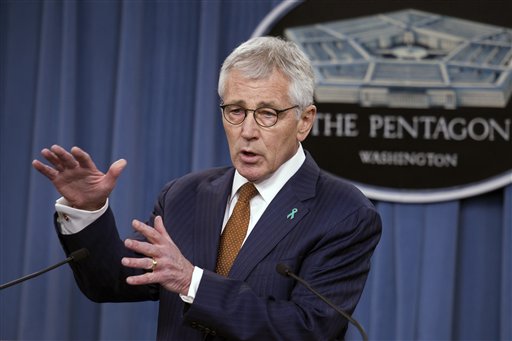Hagel on farewell tour as defense secretary to thank troops

Defense Secretary Chuck Hagel is opening a farewell tour to thank troops for their service as he prepares to turn over his duties to his designated successor, Ashton Carter.
WHITEMAN AIR FORCE BASE, Mo. >> Defense Secretary Chuck Hagel opened a farewell tour of U.S. military bases Tuesday at the home of one of the premier symbols of America’s global military reach, the B-2 stealth bomber.
Just weeks before ending his two-year tenure as Pentagon chief, Hagel flew to this air base in western Missouri to thank troops for their service and highlight his support for the planned development of a new generation of long-range nuclear-capable bombers. The tour comes as Hagel prepares to turn over his duties to his nominated successor, Ashton Carter. Carter is expected to be confirmed by the Senate sometime in February.
Hagel was getting a firsthand look at the bat-winged B-2 and holding a town hall-style session with a few hundred airmen before flying to California to visit Marine Corps aviators.
Speaking to a few hundred airmen inside an aircraft hangar and flanked by T-38 trainer planes, Hagel said the B-2 fleet plays an essential role in deterring nuclear war.
“It’s about strategic deterrence so that we don’t have to send our men and women into conflict,” he said.
He said he has kept his focus on ensuring that the US military does not fall behind in technology in spite of tighter budgets.
Don't miss out on what's happening!
Stay in touch with breaking news, as it happens, conveniently in your email inbox. It's FREE!
“The one thing we cannot fall behind in is our modernization,” he said, including building a new-generation long-range bomber. “That has to start now.”
All 20 of the Air Force’s B-2 bombers are based at Whiteman, although some are periodically stationed overseas. The B-2 was developed in secrecy in the 1970s; it has been flying since the 1990s and the Air Force says it will remain in the arsenal well into the 2040s.
Details of Air Force plans for the new bomber are mostly secret, but a Congressional Research Service report last July said the plane could eventually be “optionally manned,” meaning it could be flown as a pilotless aircraft for some missions.
The Air Force has said the new bomber is intended to play a nuclear as well as conventional bombing role, although it is not clear how many of the current bombers — the B-2, the B-52 and the B-1 — it would replace. The B-1 is not nuclear capable.
Gen. Mark Welsh, the Air Force chief of staff, told an interviewer last summer that 80 to 100 of the new bombers will be needed to replace the B-52 fleet, which dates to the 1960s.
“Our B-52s will not continue to fly until they’re 100 years old or older, although it must seem that we’re trying for that. We have to replace them,” Welsh said.
The B-2s are the only element of the nuclear force that Hagel had not visited over the past year while searching for solutions to a series of nuclear missteps, particularly by the Air Force’s intercontinental ballistic missile corps.
Last January while visiting an ICBM base in Wyoming, Hagel learned that three missile corps members were under criminal investigation for drug use. Two months ago Hagel announced plans for top-to-bottom changes in how the nuclear force is managed and for billions in added spending.
The B-2 force has been free of the training flaws, security lapses and disciplinary problems that have dogged the ICBM force in recent years.




